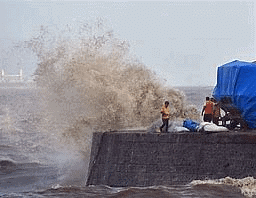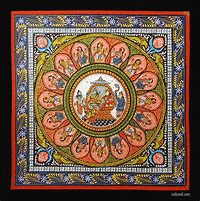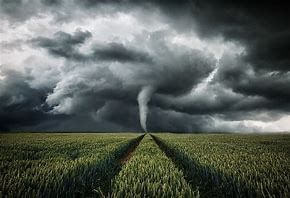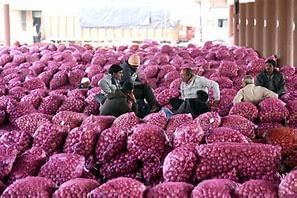UPSC Daily Current Affairs- 5th May 2024 | Current Affairs & Hindu Analysis: Daily, Weekly & Monthly PDF Download
GS-I
El Nino, Anti-Cyclone Systems, and Heatwaves in India
Subject: Geography
Source: Indian Express

Why in News?
April in India has witnessed unusually high temperatures, leading to widespread heatwave conditions, as reported by the India Meteorological Department (IMD).
- Expanding Heatwave Zones: The traditional Core Heatwave Zone (CHZ) in India, spanning regions from Gujarat to West Bengal, is no longer the sole hotspot. Areas like southern peninsular India are now experiencing heatwaves.
- Hotspot Regions: States including Rajasthan, Punjab, Haryana, Delhi, and others are particularly prone to heatwave conditions during the summer months.
- IMD Heatwave Declaration: IMD declares a heatwave when temperatures exceed specific thresholds, varying for plains, hilly, and coastal regions.
- Factors Behind April Heatwaves:
- The year 2024 began in an El Niño state, characterized by abnormal warming of Pacific Ocean waters, leading to global heatwaves.
- Anticyclone systems over southern India intensify heat by pushing warm air downwards, preventing cooling sea breezes.
- Impact of Heatwaves: This April, various regions in India, especially southern and eastern areas, experienced severe heatwave conditions, signaling a worrying trend of rising temperatures.
Patachitra Painting
Subject: Geography
Source: Down to Earth

Why in News?
The first generation women patachitra artists of West Bengal sell their work online & are recognised world over, encouraging future generations to stay in the profession
Background
- Patachitra or Pattachitra is a traditional form of cloth-based scroll painting originating from Odisha, West Bengal, and parts of Bangladesh.
- This art form is renowned for its intricate details, mythological narratives, and folktales depicted within.
About Patachitra Painting
- Patachitra painting has its roots dating back to the 12th century and is believed to have originated in Odisha.
- The term 'Patachitra' is derived from Sanskrit, where 'pata' signifies 'cloth' and 'chitra' denotes 'picture'.
- It serves as a form of narrative scroll art, primarily focusing on themes revolving around mythology and culture.
- Historically, Patachitra made its way to Bengal around three centuries ago when migrants from Odisha introduced this tradition to the region.
TORNADO
Subject: Geography
Source: MSN

Why in News?
Recently, a severe tornado hit West Bengal, resulting in five fatalities and over a hundred injuries.
Background
- In recent times, India has witnessed a rise in tornado occurrences, causing significant damage. This could be attributed to a warming Bay of Bengal, land factors, and unusual wind patterns.
About TORNADO
- A tornado is a violently rotating air column that stretches from a cumulonimbus cloud to the Earth's surface, forming during intense thunderstorms.
- Unlike cyclones, tornadoes are localized and short-lived phenomena.
- The genesis of a tornado involves a complex interplay between a supercell (a persistent thunderstorm with a deep rotating updraft) and the surrounding conditions.
- Wind shear, which denotes changes in wind speed and direction with altitude, is pivotal in creating the requisite circumstances for tornado formation.
- Tornadoes are more likely to occur where warm, moist air near the ground interacts with cooler, drier air at higher altitudes.
Composition and Impact
- Tornadoes are comprised of air, water droplets, dust, and debris.
- The visible funnel primarily comprises water droplets from condensation, along with dust and debris lifted from the ground.
- The storm's core harbors the lowest pressure and highest wind speeds, resulting in substantial destruction.
- Tornadoes can devastate structures, residences, infrastructure, vehicles, uproot trees, and transform landscapes.
- The Enhanced Fujita Scale (EF Scale) categorizes tornado intensity based on the inflicted damage, ranging from EF0 (weakest) to EF5 (most potent).
GS-II
Will R&AW's Overseas Operations Affect Ties?
Subject: International Relations
Source: The Hindu

Why in News?
India’s R&AW was in the spotlight, as reports came in from the US, Canada and Australia of the alleged killing of Indian-origin Khalistani separatist operatives around the world, spearheaded by the agency.
Key Points:
- R&AW's involvement in operations targeting Indian-origin Khalistani separatists abroad has raised international concerns.
- Allegations include an attempted assassination operation in the US and surveillance activities in Canada and Australia.
- Responses from the concerned countries vary, with India denying official involvement in extrajudicial actions.
- Despite these incidents, diplomatic relations with the countries involved remain relatively stable.
- Unspoken rules in intelligence operations include avoiding actions in friendly territories and maintaining discretion.
CONTEMPT OF COURTS ACT 1971
Subject: Polity
Source: Live Law

Why in News?
The recent observation by the Allahabad High Court regarding appeals under the Contempt of Courts Act, 1971.
Background
- The High Courts maintain jurisdiction under Article 226/227 for orders under Section 14(1) of the Administrative Tribunals Act.
- Orders falling under Section 17 of the Act are solely appealable to the Supreme Court.
About the Contempt of Courts Act 1971
- The Act defines and limits court powers in punishing contempts.
- It regulates procedures related to contempt proceedings.
- Contempt of court includes acts that scandalize, prejudice, or interfere with justice.
- Distinguishes between civil and criminal contempt:
- Civil contempt: Willful disobedience to court orders or breach of court undertakings.
- Criminal contempt: Acts scandalizing the court, interfering with judicial proceedings, or obstructing justice.
- The Act protects innocent publication not deemed contemptuous, ensuring freedom of expression.
- Enables fair and accurate reporting of judicial proceedings and criticism of judicial acts.
- High Courts can punish contempts of subordinate courts and try offenses beyond their jurisdiction.
- Specifies punishments for contempt, including imprisonment or fines.
India and Greece
Subject: International Relations
Source: MEA

Why in News?
During extensive talks between Prime Minister Narendra Modi and his Greek counterpart Kyriakos Mitsotakis held recently, the leaders aimed to inject “new energy” into their bilateral ties.
Historical Background:
- India's connections with Greece date back over 2500 years, evidenced by trade between Mauryan Kings and Greece.
- Alexander the Great's invasion of the North-Western part of the Indian subcontinent in 326 BC.
- Mentions of Yavan Ambassador in Chandragupta's court by Chanakya in Arthashastra.
- Development of Gandhara art reflecting Indian and Greek influences.
Diplomatic Relations:
- Establishment of diplomatic relations in 1950.
- Reciprocal opening of embassies in Delhi and Athens.
- Ratification of Science and Technology agreement to foster cooperation.
- Greece's support for India's NSG membership and UN Security Council seat bid.
Strategic Importance:
- Significance of India's relations with Greece and Armenia in countering emerging military alliances.
- Geopolitical advantage of Greece's location bordering the Mediterranean Sea.
- Potential for a multi-modal link between Mumbai and Europe via Piraeus port.
- Energy cooperation opportunities in oil, gas, solar, and wind energy sectors.
Defense and Security:
- Greece's increasing defense expenditure and market potential for India's defense exports.
- Engagement in joint naval exercises and multinational air force drills.
Challenges and Concerns:
- Lack of recent high-level interactions affecting strategic ties.
- COSCO's majority stake in Piraeus port posing connectivity and trade challenges for India.
- Issues in trade relations like limited business opportunities and investment.
Future Prospects:
- Potential for Greece and Cyprus to bridge EU-India ties.
- Utilization of Line of Credit, soft power, and diaspora to enhance relations.
- Collaboration on tourism promotion, maritime security, and joint exercises.
GS-III
What is Artificial General Intelligence (AGI)?
Subject: Science and Technology
Source: MSN

Why in News?
Recently, Sam Altman (OpenAI’s CEO) expressed his commitment to invest towards Artificial General Intelligence’s (AGI) development.
- AGI refers to a type of machine that is designed to imitate human cognitive functions, enabling it to carry out a wide array of intellectual tasks such as reasoning, common sense, abstract thinking, and background knowledge.
Difference between AGI and AI Being Used (Narrow AI)
- Narrow AI is limited to specific tasks like image recognition, translation, and playing games, while AGI aims for a more generalized intelligence that is not restricted to predefined parameters.
Historical Background
- The concept of AGI dates back to Alan Turing's pioneering work in 1950, where he introduced the idea in his paper 'Computing Machinery and Intelligence'.
- He proposed the Turing test as a measure of machine intelligence, suggesting that a machine displaying human-like intelligence during a conversation could be considered to possess AGI.
Benefits of AGI
- AGI has the potential to revolutionize various sectors such as healthcare and business by offering unparalleled problem-solving capabilities and fostering creativity.
- In healthcare, AGI could transform diagnostics, treatment planning, and personalized medicine by analyzing extensive datasets.
- Businesses could benefit from AGI by automating processes, improving decision-making, and providing real-time analytics and accurate market predictions.
Concerns Surrounding AGI
- AGI's development raises several concerns, including its environmental impact through high energy consumption and e-waste generation.
- There are fears of widespread job displacement and socio-economic inequality if AGI leads to significant employment losses.
- Security vulnerabilities may emerge with the introduction of AGI, potentially outpacing regulatory efforts by governments and international bodies.
- Dependence on AGI could result in the erosion of basic human skills and capabilities, leading to potential loss of control over critical aspects of life.
- Moreover, there are concerns about AGI surpassing human capabilities and acting against humanity if its control is compromised.
Centre lifts onion export ban
Subject: Economics
Source: The Hindu

Why in News?
The Indian government has recently removed the ban on exporting onions that was in place for almost six months. However, there are restrictions imposed to regulate the outflow of onions. Exporters are required to adhere to a minimum export price of $550 per tonne and also pay a 40% export duty.
Onion Production in India
- Significance: Onion cultivation is a vital agricultural practice in India and holds a key position in the country's economy.
- Varieties and Cycles: India, being the second-largest producer of onions globally, cultivates various onion types such as red, white, and yellow onions. These onions are grown in two main cycles - Rabi (November to January) and Kharif (January to May).
- Cultivation Practices: Onions are mainly grown from seeds and require well-drained sandy or loamy soil. Adequate irrigation, including the use of drip irrigation systems, is essential for their growth.
- Major Producing States: States like Maharashtra, Karnataka, Madhya Pradesh, Gujarat, and others contribute significantly to onion production in India, with Maharashtra leading the charts followed by Madhya Pradesh.
- Production and Export Statistics: The estimated Rabi crop for 2024-25 stands at 191 lakh tonnes, with a significant portion of the produce being exported to countries like Bangladesh, Malaysia, UAE, and others.
- Impact of the Export Ban Lift: The removal of the export ban on onions by the government is expected to greatly benefit farmers and traders in Maharashtra. This decision was made in response to protests by onion growers in Maharashtra, who were facing financial difficulties due to the ban.
|
63 videos|5408 docs|1146 tests
|
FAQs on UPSC Daily Current Affairs- 5th May 2024 - Current Affairs & Hindu Analysis: Daily, Weekly & Monthly
| 1. What are the impacts of El Nino on India's weather patterns? |  |
| 2. How do Anti-Cyclone Systems affect India's weather? |  |
| 3. What is the traditional art form of Patachitra Painting in India? |  |
| 4. How are Tornadoes formed and what are their impacts? |  |
| 5. How do R&AW's overseas operations impact India's diplomatic relations? |  |
















